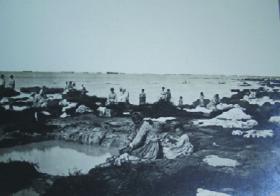Afro-Argentines
Published in 18th–19th - Century History, Features, Issue 4 (Jul/Aug 2008), Volume 16
Afro-Argentinian washerwomen on the banks of the River Plate, Buenos Aires, c. 1860. (Archivo General de la Nación Argentina)
Kate Connolly, the Irish immigrant narrator in a semi-fictional novel, saw an Afro-Argentine peach-seller in nineteenth-century Buenos Aires and remarked upon the ‘tall black woman with a woolly head’, commenting that she had seen a peach before but never an African person. The majority of forced African immigrants arrived on the shores of the River Plate during the eighteenth century on British ships from the west coast of Africa, principally from regions such as Angola, Congo and Guinea. In 1800 the African and Afro-Argentine community of Buenos Aires comprised about 25,000 people but experienced rapid decline as the century progressed, both in terms of visibility and absolute numbers. The growth of European immigration was a decisive factor in this process.
Some authors have claimed that there was racial prejudice against Irish Catholics in Ireland, Britain and North America, referring to them as ‘Black Irish’. The easy classification of Irish people in Buenos Aires as ingleses (English)—and therefore unequivocally white—questions this notion. By 1882 the London newspaper The Financier could remark that potential Irish immigrants to Argentina would not have to contend with ‘competition with “black or yellow hands”’. The demographic decline in the African and Afro-Argentine population of Argentina facilitated the invention of Argentina as a country of European immigrants.
















